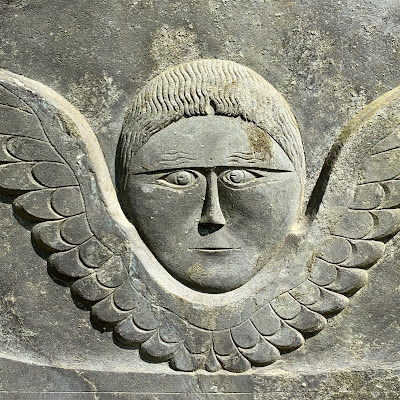I love Bigfoot stories, and the weirder they are the more I like them. Here is a particularly spooky one from Rehoboth, Massachusetts. I first heard it on the Unsolved Mysteries podcast episode "The Creatures of Hockomock Swamp," but it appeared in the local news before that.
*****
In the spring of 2019, thirty-seven year-old Tracy Manzella was visiting her parents at their Rehoboth home. Tracy and her siblings had grown up in the house, which is situated on a very woodsy road. As a child, Tracy had always felt like something in the woods was watching her whenever she was outside, but she never saw anything strange.
Rehoboth sits within the fabled Bridgewater Triangle, and although Tracy was aware of the legends and paranormal sightings associated with the Triangle she had never seen anything strange herself. Members of her family had seen strange lights in the sky or near their house, but not Tracy. Not until that cold, drizzly, spring day in 2019
Tracy had gone for a run on the country roads near her parents' house. As she made her way back, she passed by an old cemetery that sits nestled in the woods about fifty feet from the road. She had gone by it countless times before, but this time as she ran by she saw something very strange. An enormous creature stood in front of the cemetery gates.

Image from the film Abominable (2006)
The creature was humanoid, and covered in stringy red hair. It was massively built, with broad shoulders and a broad chest. It was also really, really tall. Tracy estimated it must have stood fifteen feet high. It reminded her of an ogre or a troll.
What stood out most about this fantastic creature, though, was its face. Although it was not close to the road, Tracy could see fangs, and its gray-skinned face was demonic-looking. She sensed that the creature was evil.
Tracy was terrified. She was afraid the creature would notice her and chase after her. Luckily it didn't. Tracy ran back to her parents' house, where she drew a picture for her mother of what she had seen.
She has not seen anything strange since then. In October, 2020, Tracy Manzella told a Taunton Gazette reporter the following:
"It's the last experience in the Bridgewater Triangle that I would have personally wanted to have. Not because of how scary it was, or unsettling, but simply because of all of the legends of the Bridgewater Triangle that I have read about over the years or learned about. To me, the Bigfoot sightings always seemed like the most ridiculous and far-fetched of all of the things that people have seen," she said. "...I just feel like this particular experience is so outlandish that it's hard to believe if someone tells you that this is what they've seen." ("Exploring the Bridgewater Triangle: Our reporter and photographer head out when the lights go down and the legends come out," The Enterprise, October 27, 2020).
In some ways, her encounter seems like a typical Bigfoot sighting: a large hairy humanoid was briefly seen in the woods. On the other hand, the creature was really big, even for Bigfoot. Fifteen feet tall is enormous! The fangs, demonic face, and overall evil vibe are also atypical for Bigfoot sightings.
Local paranormal investigator Christopher Pittman was quoted in the podcast, saying that almost everyone who reports seeing a Bigfoot in the Bridgewater Triangle describes something slightly different. Witnesses describe creatures of different heights, with different colored fur, and a variety of faces. None of them are the same. So perhaps there isn't a typical Bigfoot encounter, even in relatively small area like the Bridgewater Triangle.
I don't think that Bigfoot is a physical animal, although many people would disagree with me. I think people who encounter Bigfoot are probably having a mystical experience of some kind, and that Bigfoot is a land spirit or genius loci, as the Romans would call it. The Romans and Greeks believed the wilderness was haunted by satyrs, centaurs, and nymphs. In America, we believe it's haunted by a large hairy humanoid.
The fact that Tracy saw the giant creature near a cemetery also seems significant somehow, as does its menacing appearance. Cemeteries are of course believed to host to a variety of supernatural beings, including ghosts, vampires, and occasionally demons, but the way this creature blocked the cemetery gate immediately made me think it was some type of guardian.
In several European cultures, people believe that a cemetery is guarded by the spirit of the first being buried there. In many cases the guardian will be a human spirit, but sometimes it might be the spirit of an animal that was killed and buried explicitly for this purpose. For example, in England cemeteries are often guarded by spectral black dogs (called church grims) which are believed to be the ghosts of dogs killed and buried there. Cemetery guardians need not be so specific, either. A local friend of mine will pour out water or leave a coin for the guardian when he visits a cemetery, but I think he just considers the guardian the spirit of the place, not the soul of the first creature buried there.
So did Tracy Manzella see the cemetery's guardian spirit? I really don't know, and it's not something that can be proven, but the creature's size, position and terrifying visage certainly would prevent anyone from entering that graveyard. It's just speculation on my part, and I certainly don't think the first being buried in the cemetery was a fifteen-foot demonic creature. She may have experienced something else entirely, but I enjoy tying these modern paranormal encounters with older streams of myth and folklore.





